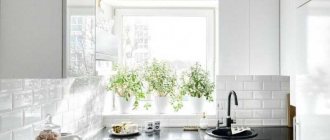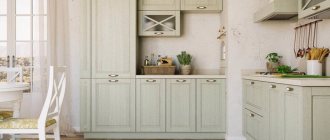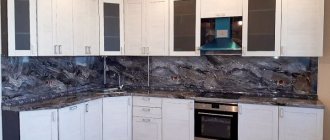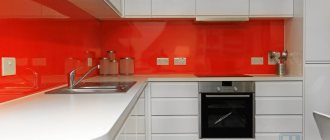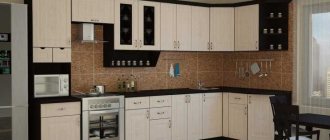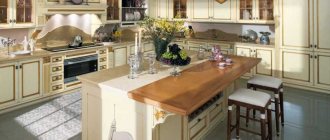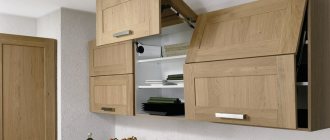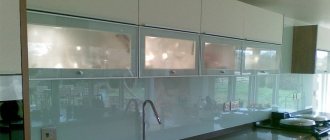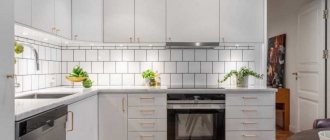Types of layout
Depending on the shape and size of the room, and the lifestyle of the household, you can choose one of six main options for planning a kitchen unit. We will consider below what methods exist for arranging furniture and equipment.
Straight (single row)
One of the most common and versatile options is to place furniture and appliances along one long wall.
A straight kitchen layout is preferable for rooms of 4-6 square meters, as it allows you to compactly organize the workspace and leave room for free movement.
For a narrow, elongated rectangular room, reminiscent of a carriage, a linear arrangement of furniture may be the only possible one.
Corner (L-shaped)
When it is impossible to arrange all three main zones along one wall, you can organize a corner or L-shaped layout.
It is also more convenient in terms of the work triangle.
The main problem of the L-shaped layout is the rational use of corner space. To make the most of every centimeter, choose a corner module equipped with a carousel with shelves or a pull-out section.
You will find more interesting options for arranging a corner kitchen here
U-shaped
The U-shaped layout is functional and spacious, but requires a large area for implementation.
But there may be exceptions here too. In a small kitchen, you can also make a U-shaped layout, but there will be no room left for a full-fledged dining area.
In this case, a small kitchen can only be a workroom for preparing food, and the dining room will have to be organized in the next room. In the kitchen, install a mini-stand for quick snacks or morning coffee.
With a U-shaped layout, it is necessary to take into account the distance in the aisles between cabinets - at least 1.2 meters. But this distance should also not be too large, so that you don’t have to walk a lot during the cooking process.
With island and peninsula
An island kitchen layout also requires space. It is impossible to install an island in a small or even medium-sized room.
Spacious kitchens in private homes are best suited for an island set, where it is easier to connect communications to the island and place a sink or hob on the island module.
In apartment buildings, an island arrangement of furniture is possible if the kitchen is combined with the living room, or if the apartment originally had an open layout. At the same time, it will not always be possible to connect communications, since the wet zone can legally only be moved along one wall. Ideas about building a podium under which communications will be hidden are troublesome and often involve a violation of the law. The best option in this case is to make the island an additional storage module and work surface.
You will find more fresh ideas for kitchen design fashionable in 2021 in our separate article.
An island or peninsula can serve as zoning in a kitchen-living room or studio.
Here you can organize a bar counter, which in a small apartment will serve as an independent dining area.
Parallel (double row)
This arrangement is ideal for rectangular rooms. But it is important to take into account the minimum recommended distance between rows of cabinets - 1.2 meters. Too large a distance is undesirable, since during the cooking process you will have to walk a long distance from one functional area to another.
To save space, one of the rows of cabinets with a parallel layout can be made smaller in depth - not the standard 60 cm, but, for example, 30 cm.
For the dining area, in this case there is space left at the end of the room, usually near the window, or between rows of cabinets.
With bar counter
The bar counter often acts as a single whole with the design of the kitchen unit. By extending the tabletop, you can create a bar counter under the window, connecting it to the window sill.
Or make a U-shaped layout from a corner layout.
In this case, the bar counter will serve as an additional work surface and perform a zoning function.
The bar counter can be equipped with an island or a peninsula.
Watch also a useful video on how to choose a layout:
Let's sum it up
Independently planning the details of the furnishings of your future home is an exciting and responsible process that can drag you in because you are actually creating a picture of a future happy life in a new place in your head, and at the same time repel you, since after all, planning involves studying a lot of difficult and not for all interesting nuances. However, if you firmly take up the matter and approach it with all responsibility, everything will turn out just fine.
Everyone knows that a kitchen is needed not only for cooking, but also for relaxation, as well as pleasant gatherings with the whole family or with guests. That is why, even with limited space, it is necessary to ensure maximum comfort in this room. In a special article we will look at kitchen designs with an area of 10 sq.m.
Video - Correct kitchen layout and proper location
Video – Kitchen planning
Rules for proper planning
Before you start designing, it is useful to study recommendations for the placement of the main functional areas of any kitchen: refrigerator, stove and sink. This will help make the cooking process easier and faster.
Triangle rule
The main problem with planning a kitchen set configuration is not knowing where to start. In this case, the working triangle rule will always help, which gives an understanding of the proper distribution of the main zones:
- storage areas (includes refrigerator and food cabinets);
- areas for preparing food for cooking (represented by a sink and part of the work surface);
- cooking area (hob, oven, microwave, cabinets for storing dishes and cooking utensils).
Depending on the shape of the room and the layout of the set, you can choose several ways of the relative arrangement of these three zones. Possible options are presented in the picture below.
Working triangle rule for linear, corner, U-shaped, island layout
The working triangle rule was derived from the idea of the sequence of the technological process of cooking. It is designed to make moving between zones as comfortable as possible and, as far as possible, less costly in terms of time and effort.
Does the work triangle rule always work? We recommend that you follow it as a RULE, but not as a LAW. There are times when it is necessary to retreat from it. This often happens due to the location of communications and when planning a set for a very small kitchen of 4-5 sq.m., or for a room of a non-standard shape, with architectural features.
But, even if you had to deviate from the rule of the working triangle, one thing always remains relevant:
The presence of buffer zones between the three main zones is mandatory!
Minimum recommended distances
There should be some distance between the refrigerator, stove and sink, a work surface, so that you can put food from the refrigerator or cabinet somewhere and prepare it for subsequent heat treatment.
- Between the refrigerator and the sink - at least 60 cm.
- Between the sink and the stove - at least 60 cm.
- Equipment cannot be placed close to each other. This is fraught with disruption of its work. If the refrigerator and oven are located next to each other, then they should be separated by at least a small module 15-20 cm wide;
- You should not place the sink close to the wall so that you do not have to constantly wipe up splashes. It is recommended to retreat 10-15 centimeters. If the sink has a wing, then this distance can be occupied by the wing.
- Between the hood and the work surface - 55-65 cm for an electric stove and 70-80 for a gas stove.
- Between the refrigerator and the wall - at least 7 cm.
- Sockets in the work area and behind cabinets should not be located near the sink.
In a small kitchen, it is not always possible to follow the distance recommendations listed above. You can move the sink closer to the refrigerator, but (!) not to the stove. There should always be a distance between the hob and the sink equal to the minimum working surface - 60 cm.
The correct working triangle using the example of a small kitchen
Too large distances between the three main zones are also undesirable. The recommended maximum is 2.5-3 meters.
Where to put the refrigerator?
The question of where to put the refrigerator is most often asked by owners of apartments with a small kitchen, or when it is impossible to comply with the working triangle rule for some reason. The problem lies in the dimensions of the refrigerator itself. How to find the best place for it in different conditions? Below are some possible locations:
- In the corner near the wall, to the left or right of the unit - a classic option that allows you to harmoniously fit the refrigerator into the interior of any size.
- Near the window, unless it blocks the light. This arrangement option can often be found in Khrushchev-era kitchens.
- In a niche formed after redevelopment. Again, this is the most typical situation for Khrushchev houses, in which the entrance to the kitchen was moved into the room, and a niche was formed in the place of the former corridor.
- Separate from the kitchen unit on the opposite wall. This option is possible when the wall is not long enough to place furniture and a refrigerator in one row. Or when the refrigerator is a bright accent in the interior and needs to be highlighted. This location is also relevant for side-by-side refrigerators.
- Take the refrigerator out into the hallway/closet/room. This is inconvenient, but may become a necessary measure. For example, when the kitchen is so small that the refrigerator simply does not fit in it under any circumstances.
Built-in refrigerators look most harmonious in the interior. The exception is bright, colored equipment, which does not need to be hidden behind a facade.
If you need to fit in a freestanding refrigerator, then it is better to do this using one of the methods suggested below:
- Choose a refrigerator and facades of the same shade. For example, a white refrigerator and white facades.
- Build a refrigerator into a niche of kitchen cabinets. To do this, even at the design stage it is necessary to provide a cabinet above the refrigerator. It is better in this case if the set is located under the ceiling.
- Close the freestanding refrigerator in the closet. The difficulty is to find a cabinet suitable for the size of the refrigerator, taking into account the margin between the wall and the refrigerator of 7 cm on each side.
Do not place the refrigerator close to the wall or stove. The equipment must remove heat during operation. Violation of this requirement will result in failures and breakdowns. We have already given the recommended distances between the refrigerator and the wall/stove in the paragraph above.
Passage width
To make movement between the main areas of the kitchen convenient, take into account the minimum requirements for the width of aisles when designing:
- between low furniture for the passage of one person - at least 60 cm, for two - from 90 cm;
- between high furniture and the wall - at least 90 cm (for one) and from 120 cm (for two).
Also allow distance for opening the interior door (if there is one) and for opening cabinet doors. In order to save space in a small kitchen, it is more advisable to install sliding rather than hinged interior doors.
Using ledges and niches
Niches and protrusions are more commonly considered a disadvantage of the interior. Indeed, in this case there will be more hassle with designing a kitchen, especially if the niche or ledge is located directly in the area where the furniture is installed and divides the wall into 2 parts. But there are several tricks on how to turn these design flaws into advantages.
Niche solutions
- Equip a niche for a built-in wardrobe. And these are additional storage spaces that are never superfluous.
- If you cannot install a built-in wardrobe in a niche, you can always cover it with plasterboard.
Overhang Solutions
- Go around the ledge with the headset.
There are fewer problems if the ledge is in the corner.
If the size and shape of the room allow, then you can install a linear layout and then the protrusion ceases to matter. In the case of an L-shaped layout, or when the protrusion is in the middle of the wall, it is necessary to adjust and cut out part of the module for it.
If the width of the overhang is equal or almost equal to the depth of the kitchen cabinets, then you can not cut anything, but simply place the kitchen on both sides of the overhang, as shown in the photo below.
- Build on top, level the wall with plasterboard. In this case there will be pros and cons. On the one hand, a flat wall does not create problems with the selection and installation of kitchen units, on the other hand, centimeters are lost, which are never superfluous in a small room.
You can build on not only the wall to the right or left of the ledge, but also the ledge itself. For example, when you need to bring it to the depths of cabinets in order to dock with them. This solution is often used to install an L-shaped set.
- In the upper part of the set, the box can be made the main accent, highlighted with an interesting apron, or disguised, surrounded by shelves or leveled in the upper cabinets in one row.
Preparatory stage
Before drawing up a kitchen design project, you need to gain knowledge in this area. There is no need to become a guru in drawing and carpentry. It is enough to know basic information.
We recommend obtaining information from the following sources.
- Video tutorials on kitchen design from professionals. They detail the stages and features of the work. Since this is a preparatory stage, you should not immediately try to repeat what is described in the video. You just need to understand the principle of the upcoming actions.
- Friends who recently renovated their kitchen. Ask them how they solved the problem of small footage, what program they used to draw, and whether they encountered any problems. A live interlocutor will give the most complete answers to the above questions.
- Kitchen workshops and furniture stores. Any client can get a free consultation and even make an approximate kitchen design in the department of a furniture hypermarket. To do this, it is not necessary to use other services of the company (buy furniture, etc.). Organizations charge a fee for detailed consultation, but it is limited to only 1 thousand rubles. For this money you can get advice on arranging furniture, electrical appliances, and choosing a style specifically for your room. Individually tailored recommendations are always more useful.
- Magazines, TV channels, and other media sources that provide access to information about repairs. By casually looking through texts or programs, you can glean several useful ideas - how to save space, arrange furniture more conveniently, etc.
Below are general instructions for designing a kitchen unit on your own. Remember that when developing a drawing, you must take into account the specific features of your specific room (footprint, presence of unevenness on the walls, location of communications, and so on).
Which layout should you choose?
When choosing a layout, you have to take into account, first of all, the location of communications - water supplies, sewer drains. But this is not the only thing that will affect the configuration of kitchen furniture. To choose a layout, it is important to take into account not only the architectural features of the room, but also the living conditions and lifestyle of the household:
- what is the composition and size of your family?
- How much time do you or your household spend in the kitchen?
- Is everyone used to gathering together at the dinner table? Or is everyone used to having lunch/dinner in their own room?
The answers to these questions will give you a clear understanding of what exactly you need.
For example, if the family likes to get together for lunch or dinner as a whole, then a large dining table is needed, and, therefore, this needs to be coordinated with the dimensions of other furniture, especially in a small kitchen, where it is not so easy to allocate space for a full-fledged dining area.
If you often cook a lot for a large family, then in a small kitchen it is possible to implement a U-shaped layout, but in this case the dining area will most likely have to be moved outside of it and a dining room can be organized in the adjoining room.
This may also be interesting: Three secrets of a comfortable and practical kitchen.
Based on the shape and size of the room
To summarize, we summarize all of the above into brief instructions in the form of a table.
| Dimensions and shape of the room | Optimal layout option |
| Small kitchen 4-6 sq m | Linear or angular |
| Square room | Corner |
| Rectangular, narrow and elongated | Linear or parallel |
| Large kitchen-living room or studio | Any layout will do, but often the most successful layout is island, peninsula, or U-shaped. |
| Irregularly shaped, with extra corners | Linear, double row |
Kitchen set in bay window
Taking into account the number and size of cabinets, the headset
When choosing a kitchen layout, you should take into account the lifestyle and real needs of the family. For one or two people, a small, compact corner or straight set may be sufficient.
For a large family that is used to having breakfast, lunch and dinner at home, you will need a spacious kitchen set with plenty of cabinets. In a spacious room there will be no problems with fitting everything you need if you choose a corner, island or U-shaped layout.
If the room is small, but you need to fit a large set of appliances and kitchen utensils, you need to make good use of every centimeter:
- install upper cabinets to the ceiling. They can be used to store things that are rarely used;
- use tall column cabinets;
- rationally use corner modules by installing the “magic corner” system;
- use the kitchen basement for storage;
- Properly organize storage inside cabinets using special organizers.
If there are 2 windows or access to a balcony
A room with windows on both sides has the advantage of good natural light. But at the same time, it is problematic to arrange kitchen furniture in a standard way.
In this case, you can implement almost any layout, but at the same time partially abandon the upper cabinets.
You can compensate for storage using tall column cabinets installed in the corner. The main thing is not to block the window.
The space under the windows can be used as a work surface by removing the window sill, or the sink can be placed opposite the window.
Stylistic directions and colors
In modern layouts, built-in furniture is more common, which makes the interior complete and harmonious. In addition to clear functionality, it must be beautiful and stylish. For each type, you can use any option. Among the variety of styles, the following directions are chosen for kitchens:
- Provence. Homely warmth and comfort, a variety of indoor flowers make the room spacious and light. Light colors and natural materials in decoration and furniture predominate.
- Classic. The discreet, functional style does not accept intrusive elements. The space in the kitchen is planned rationally, each item has its own purpose. The characteristic color range is all shades of brown, from light beige to dark brown.
- Country. Built-in appliances are hidden in cabinets and behind the facades, furniture and a dining table with a patina effect. The rustic style will only look true with a lot of textiles. There must be linen curtains, rugs, pillows on sofas and chairs. Light colors and natural materials are used for decoration.
- Modern. No decor, only the most necessary items. A practical, comfortable interior with strict lines can be decorated in any color. The main thing is complete harmony of tones and the presence of warm lighting.
- High tech. As much glass and metal as possible. The kitchen is filled with electrical appliances using the latest technology. Only clear lines and respect for proportions. The color scheme is expressed in two colors - one primary, the second additional.
Kitchen zoning
When planning your kitchen, it is important to use zoning techniques. They can change the perception of space, helping to create coziness and a comfortable environment.
You can visually separate the kitchen work area from the dining area using lighting, color, wall finishing materials, etc.
Zoning elements are often partitions made of plasterboard, glass or wooden slats.
In a large kitchen or kitchen-living room, the current method of zoning is a peninsula, island, bar counter or sofa installed with the back to the set.
Kitchen sketch - how to design a kitchen yourself on a computer or on paper
The dream of any owner is to have a comfortable, stylish, unparalleled kitchen. Design proposals are very diverse, but expensive, so it’s worth trying to make a kitchen sketch yourself. To do this you will need paper, pencil, tape measure, cardboard, glue and a good mood.
Features of the kitchen-living room layout
When choosing the layout of a kitchen-living room set, there will be some zoning nuances, since in addition to the kitchen and dining room, there is also a living room. At the design stage, you should immediately take into account all these three zones in order to correctly arrange the furniture.
- When choosing a place to install the unit in the kitchen-living room, you should first of all be guided by the communications connections (water, sewer). Choose a layout and start arranging cabinets, starting from the location of the sink and refrigerator.
- For the dining area, plan the space based on your lifestyle, composition and size of your family. This could be a compact bar counter in a small studio or a long dining table for a large family.
- The sofa can be installed opposite the kitchen unit against the wall or with its back facing it. There are also options for perpendicular placement.
Don’t be afraid to deviate from the standard arrangement of furniture – around the perimeter. A dining area or sofa can be installed in the middle of the room to zone the space.
Read all about the design of the kitchen-living room in a separate article - go.
Useful tips for working with the constructor
For the designer to work correctly, it is best to design on a desktop PC or laptop. The program is also available from mobile devices (iOS or Android), such as a tablet or smartphone (iPhone, iPad, Android), but is likely to work slower due to their lower processing power.
When you are immediately ready to order a kitchen set, you can send a request for a quote in real time.
You can also send an unfinished sketch. You just need to describe all possible wishes. During the ordering process, it will be finalized.
Choosing the color of the room
Before designing a kitchen, you need to decide on the color scheme of the room, which will depend not only on the wishes of the owner himself, but also on the size and lighting of the room.
You can visually increase the area of a small room by choosing furniture and wallpaper in light colors: beige, light green, yellow, pale blue. A kitchen made in these colors will appear wider and the ceilings higher. A visual increase in space can be achieved by using glossy and mirror surfaces.
In large rooms, the effect of emptiness can be avoided by using rich, warm shades. You can visually reduce the space with black, dark purple, emerald furniture, brown wallpaper and a blue or dark beige ceiling.
There are also neutral colors that do not affect the perception of the volume of the room. These include gray, dark red, green. A kitchen in which these shades predominate will appear the same size as it actually is. When creating a kitchen design project, it is worth considering that vertical lines elongate the room, and horizontal lines expand it. Wallpaper or inserts with a large pattern visually increase the volume of the room; on the contrary, they reduce the volume of the room with a small one.
If the windows in the kitchen face north, then the room may lack natural light. In this case, the kitchen should be designed based on reflective colors: white, cream, light green. The lighter the shade, the more sun there will be in the room. And vice versa, if the kitchen faces the sunny side, you can safely opt for dark furniture in cool shades: purple, blue, black.
